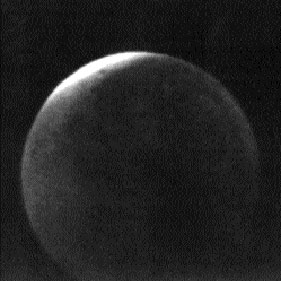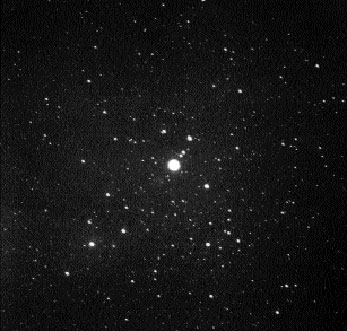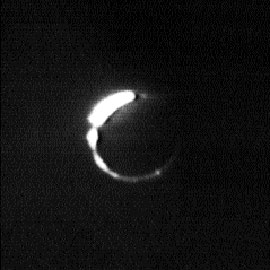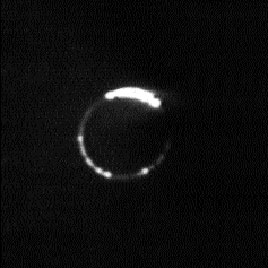|
Observe Eclipses!
|
||||||||||||
|
Introduction. With second contact, the moon completes its journey into the umbra. For as long as the next 104 minutes (but usually a shorter period) the moon will be completely shielded from the sun’s direct rays, glowing only with the gray to reddish–orange sunlight the earth’s dense atmosphere refracts around the planet’s limb. For all its beauty and the suspense it has generated as to what color and how dark the moon would appear during this particular totality, if we compare it to that of a solar eclipse, second contact is almost anticlimactic. There are, to be sure, interesting and important projects to pursue during totality, but the partial phases seemed far more hectic. Now, the totality phenomena exhibit themselves for your observation for a considerable length of time while undergoing only the subtlest of changes until third contact’s arrival, when the moon’s leading edge once more breaks free of its umbral embrace.
Contact timings. As the moon’s leading limb approaches the umbra’s edge, it is fairly easy to anticipate second contact. Third contact is more challenging, for the moon’s trailing limb brightens significantly during the waning minutes of totality. Small apertures, low magnifications and filters are best for enhancing the contrast at the umbra–penumbra boundaries, especially for very bright eclipses. Attempt timing accuracies to 0.1 min (6 sec) and employ the customary procedure of tape recording voice over WWV or CHU time signals for best results. General color and uniformity. Carefully characterize the tones and colors of the umbra during totality, while remaining alert to any variations in these characteristics with the passing of time. To capture the colors of the moon, many observers employ standard paint charts or color wheels illuminated by a white light source. Artistic observers frequently recreate the color by combining watercolors or oils at their palettes until they get the best match. Watercolors seem to recreate the subtle tints best. Photocopies of lunar maps on water–resistant paper stock provide an excellent medium for artists wishing to make frequent watercolor renderings of the changing hues and textures as the eclipse progresses. Once captured, these preliminaries may be transferred to canvas to depict a single moment of totality or, in a sequential fashion resembling a multiple–exposure photograph, to depict the whole of totality. Monitor various lunar features for visibility within the umbra, especially those which are close to the limiting resolution of your instrument. Employ a variety of color filters to determine which ones best enhance the visibility of specific features. Eclipse luminosity. The darkness of the moon’s surface at mid–totality is governed by the degree to which the earth’s atmosphere absorbs the sunlight being refracted around the planet’s limb and into the umbra. This, in turn, is determined by how dusty and cloudy the earth’s atmosphere is at the time. If there have been major volcanic eruptions, widespread sandstorms, major forest fires or the maximum of a major meteor shower (which may trigger increased cloudiness and rainfall) in the months preceding an eclipse, the moon may be almost invisible during totality, as with eclipses in 1963 and 1964. A five–point subjective scale for evaluating the moon’s luminosity at mid-totality, proposed by French astronomer André–Louis Danjon (1890–1967), has provided amateurs with an invaluable tool for directly comparing modern lunar eclipses and evaluating written descriptions of historical ones (see Table 15–1).
The strikingly dark eclipses of 30 December 1963 and 24 June 1964 were assigned values of L = 0. More recently, the 30 December 1982 eclipse was rated L = 0.3 while select estimates of the 9 December 1992 eclipse ranged from L = 0 to L = 1.2, illustrating the common practice of using intermediate decimal values with the Danjon scale. Bright eclipses were observed on 16 September 1978 (L = 2.5) and 4 June 1993 (L = 3). Make your Danjon luminosity estimates with the unaided eye or with low–power binoculars; if you are torn between two of the scale’s descriptive criteria, by all means interpolate decimal values. It is recommended that you make one estimate as close to mid–totality as possible, and two others shortly after second contact and just before third contact. These estimates will establish L–values for the outer umbra. Note the times of each estimate and the instrument used, if any. Apparent magnitude. During totality, the full moon’s usual magnitude of –12.7 may drop by a factor from 10,000 to 1,000,000 times; to anywhere from magnitude –2.7 to +3.3 or fainter. The previous chapter dealt extensively with apparent magnitude estimates of the partial phases; those techniques should be carefully reviewed and applied during totality as well. Use the method and comparison stars best suited to the unique conditions of each totality. Lunar transient phenomena (LTP). Chapter 14 also dealt with this important area. Monitor the lunar features identified in Table 14–4 during totality as well as during the partial phases. You’ll find you not only have more time for the task, but the umbral dimming and color can make these subtle changes more apparent.
Stellar total and grazing occultations. During totality, the moon’s limbs are dark enough to make the disappearances and reappearances of faint stars encountered by the moon’s inexorable eastward drift through the heavens readily visible. Occultations are predicted well in advance and widely disseminated through astronomical publications, or are available for your viewing site through the International Occultation Timing Association (I.O.T.A.). A nominal fee is charged for non–members. Timings require access to WWV or CHU radio time signals, a tape recorder, and a telescope adequate to the task, and timings should be made to the nearest 0.1 second with an accuracy as close to 0.2 second as possible. You also need to obtain the precise latitude, longitude and elevation of your observing site from a topographic map if your observations are to have any value. Stars will disappear along the moon’s western limb (celestial east) and reappear at the eastern limb (celestial west) for total occultations, and will be close to the polar regions for grazing occultations. Grazes present greater challenges, for you generally have to travel some distance to get the star and the moon in proper alignment and there may be multiple disappearances and reappearances in rapid succession as the moon’s mountains and valleys pass your line of sight. On rare occasions, planets, asteroids, comets and deep–sky objects may be occulted during totality; these can be especially exciting and observationally important events. I.O.T.A. is especially interested in receiving timings of grazing and total occultations made during lunar eclipses. Meteors. Meteor observations take two forms. You might want to watch for large meteor impacts on the moon’s surface (of course, you can do so for much longer periods on the moon’s earthlit surface between full moons). Or, you might prefer observing sporadic or shower meteors which would otherwise be “washed out” by the full moon’s light were no eclipse in progress. Lunar meteor impacts are best watched for by remaining alert to their possibility while conducting other observations, most notably high–power monitoring of LTP and other features with large–aperture instruments. Large impacts are considered exceedingly rare and, even if one occurs, likely to be misinterpreted as an LTP of lunar origin. Observers with modest equipment and an interest in meteor observing may want to stretch out in a lawn chair during totality and monitor earthly meteor activity. An hourly count might be made, or more extensive data on the times (to the nearest minute), magnitudes, durations, train characteristics and paths of observed meteors may be recorded. These data may be especially important if the eclipse falls near the maximum of a major meteor shower. Others may want to use binoculars or telescopes to watch for fainter telescopic meteors. Select a familiar star field having stars of wide–ranging magnitudes to simplify estimates of meteor brightness. Meteor observations should be forwarded to one or more of the following: the American Meteor Society, the Meteor Section of the Association of Lunar and Planetary Observers, the International Meteor Organization, and the newsletter Meteor News. Variable stars. The fainter novae, short–period, and irregular variable stars might be observed and their magnitudes estimated during totality if the cycle of the full moon is likely to make them otherwise unobservable for a week or so. Report observations to the American Association of Variable Star Observers. Artificial satellites. In addition to the brighter artificial satellites, which are easily seen even against the fully–illuminated full moon, totality presents an opportunity to observe some of the fainter and higher ones which may be having favorable passes at the time. Most satellite enthusiasts have computer software which generates predictions for their sites. Photoelectric photometry. As with the partial phases, photometric measurements of the umbra should continue during totality. Singling out specific lunar features for photometric monitoring, especially those on the LTP list, can yield very valuable confirmation of any changes detected by visual observers. You may also want to map the brightness variations within the umbra. The International Amateur–Professional Photoelectric Photometry organization can provide guidance. Photography. In addition to the multiple and trail exposures recommended in Chapter 14, telescopic photography of the moon at all available magnifications should be attempted with still, video and CCD systems.
Amateurs with more than one camera may want to use a variety of different color and black–and–white emulsions for still photography; others will have ample time to change film types during totality. Particularly spectacular occultations might also be photographed, either with a sequence of exposures or by guiding on the moon and letting the star trail until it disappears, or letting it trail after it reappears. Short time–exposures, around 5 minutes, with wide–field and standard lenses, should capture bright meteor activity without serious film fogging. |
||||||||||||



